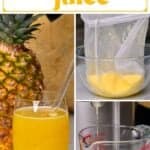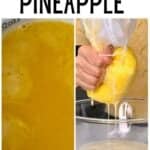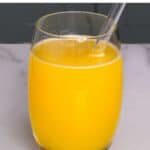This post may contain affiliate links. Please read our disclosure policy.
How to juice pineapple with or without a juicer. This tangy, sweet, refreshing homemade pineapple juice is perfect for adding to juices, smoothies, cocktails, glazes, and more!
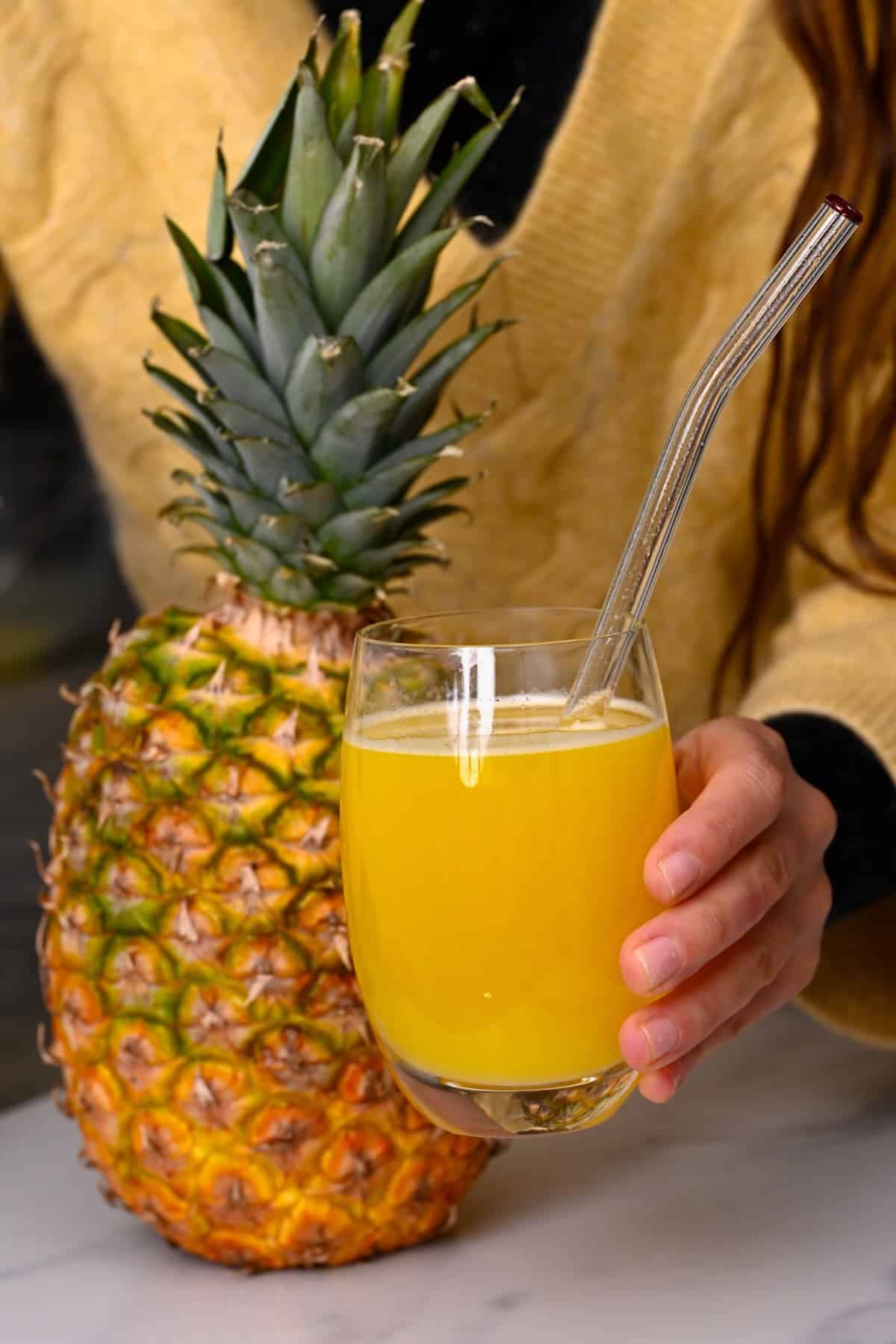
Pineapples are wonderfully refreshing, sweet, tangy, and just ever so slightly tart, making for wonderfully summery recipes! I’ve already shared recipes for tropical pineapple lemonade, pineapple orange juice, and pineapple ginger juice. Surprisingly, though, I didn’t think (until now) to share the simple methods I use for how to make pineapple juice with and without a juicer.
Using either a juicer, blender, or even machine-free method, you can prepare fresh, homemade pineapple juice in 10 minutes, with no need for extra sugar, additives, and preservatives like the versions found in your local grocery stores. More so, by making it fresh, you can take advantage of optimal nutrient absorption!
The fresh pineapple juice is perfect for adding to fruit blends (a list of optional combinations is below), smoothies, marinades, and more! Even better, along with the delicious flavor, this healthy juice is packed with several health benefits, too!
Table of Contents
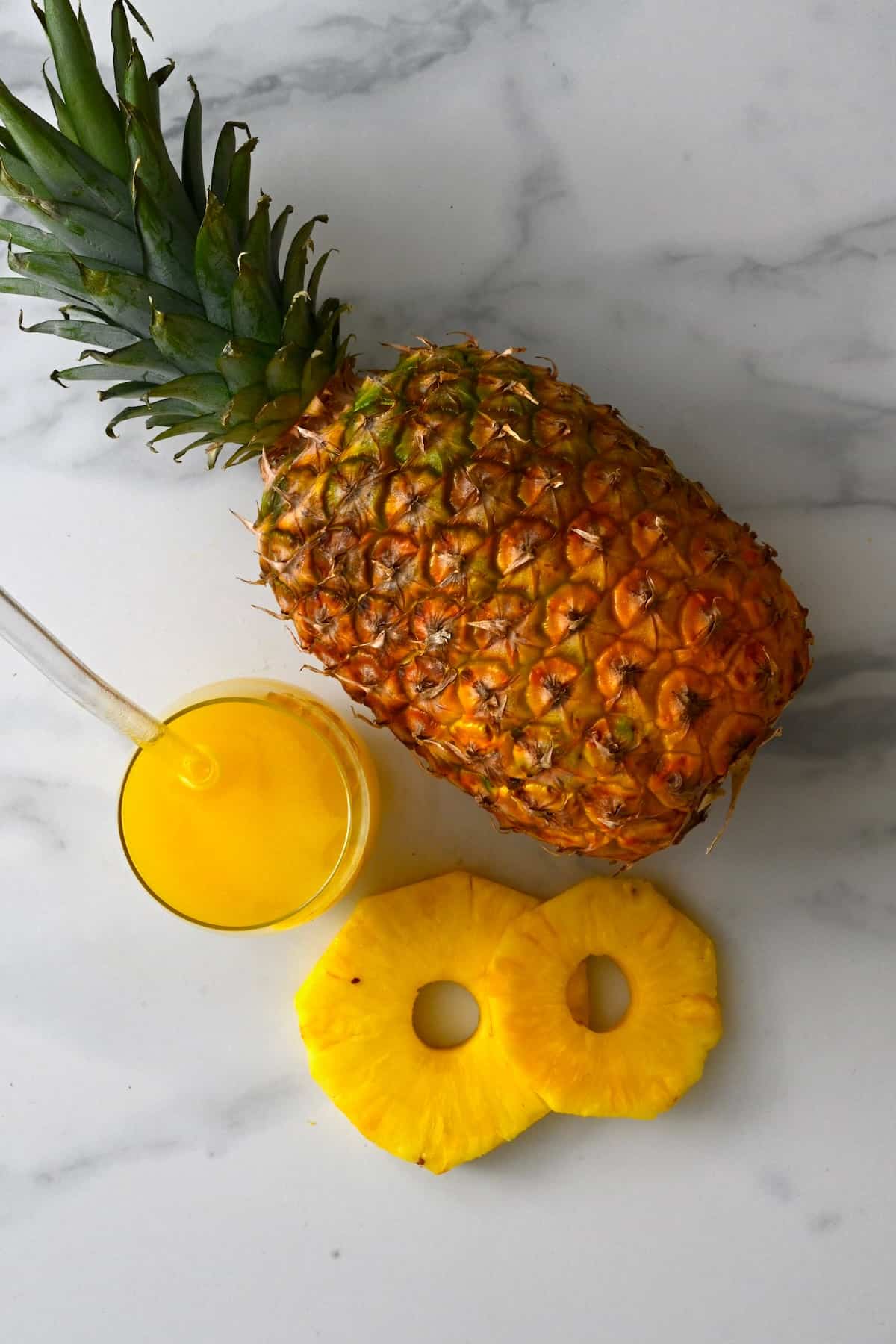
Is Pineapple Juice Good For You?
I’ve discussed this previously. However, here’s a brief look at the fresh pineapple juice benefits!
- Highly nutritious: with several vitamins/minerals, including vitamin C (100%), manganese (55%), Copper (19%), vitamin B6 (15%), etc., in just one 250ml cup.
- Immune system booster: thanks to vitamin C (an antioxidant).
- Anti-inflammatory: thanks to the bromelain enzyme in the pineapple, which also improves immunity and digestion!
- Anti-cancerous: once again, thanks to the bromelain and antioxidants, which help to eliminate harmful free radicals (and cancerous cells) and oxidative stress.
- Digestive aid: bromelain is at it again (along with the fiber when drinking the unstrained juice) to improve gut/bowel health.
Just be careful not to consume too much in one sitting, as it still contains high levels of fruit sugars, and the bromelain can also cause some mouth discomfort and tummy/digestive upset.
Want to try more ways to enjoy pineapple? You may enjoy this cucumber pineapple salad, anti-inflammatory pineapple skin tea, or refreshing tepache drink. Plus, if you like to snack on it (like me), you might also enjoy this “peeled pineapple” hack!
What You’ll Need
- Pineapple: use fresh, ripe pineapple.
How to Pick a Ripe Pineapple
My preferred method is by smell. Smell the base, and if there’s not much of a smell there, or it’s faint, then it’s likely been harvested too early or isn’t sweet. It should smell sweet and fresh (the same way you want it to taste). The pineapple should also be heavy for its size and firm, with a very slight give when pressed.
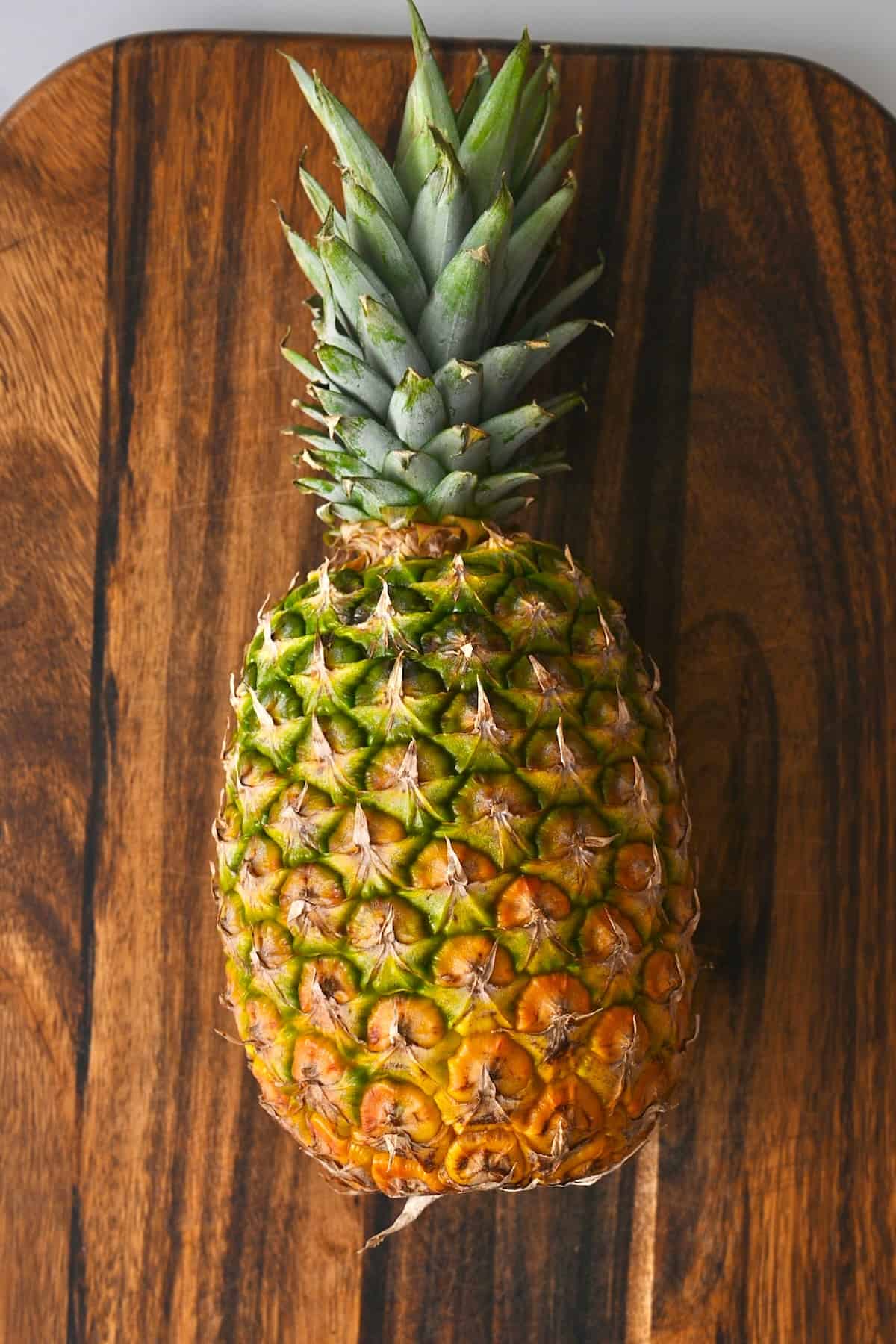
The Optional Mix-Ins
- Sweetener: if your pineapple isn’t particularly sweet, you could add a small amount of your favorite sweetener (granulated or liquid, like coconut sugar, honey, agave, etc.). Use a sugar-free sweetener like erythritol/swerve if preferred.
- Lemon/Lime: a small squeeze of fresh lime or lemon juice added to the fresh pineapple juice is a wonderful way to brighten the flavor further.
- Cumin powder: for an Indian twist add a pinch of cumin.
- Mint: serve the juice with a few mint leaves. You won’t regret it.
- Black salt: this doesn’t smell great but really works with pineapple juice and pairs well with cumin too.
- Salt & Black pepper: it may sound a little odd, but it really works to add that “something extra” to the fresh juice.
- Coconut water: the coconut water dilutes the juice mixture while adding flavor for a super tropical treat.
Flavor Variations
To say there are probably 100+ ways to enjoy this fresh pineapple juice is probably still an understatement. However, here are just a few of my top ideas off the top of my head.
- Pineapple ginger juice
- Pineapple orange juice
- Cranberry pineapple juice
- Mango pineapple juice
- Cucumber pineapple juice
- Celery pineapple juice
- Carrot pineapple juice
- Apple pineapple juice
- Orange pineapple apple juice
- Add spinach or kale (usually with apple, too)
- Coconut rum and pineapple juice (for a Pina Colada style juice)
- Add vodka.
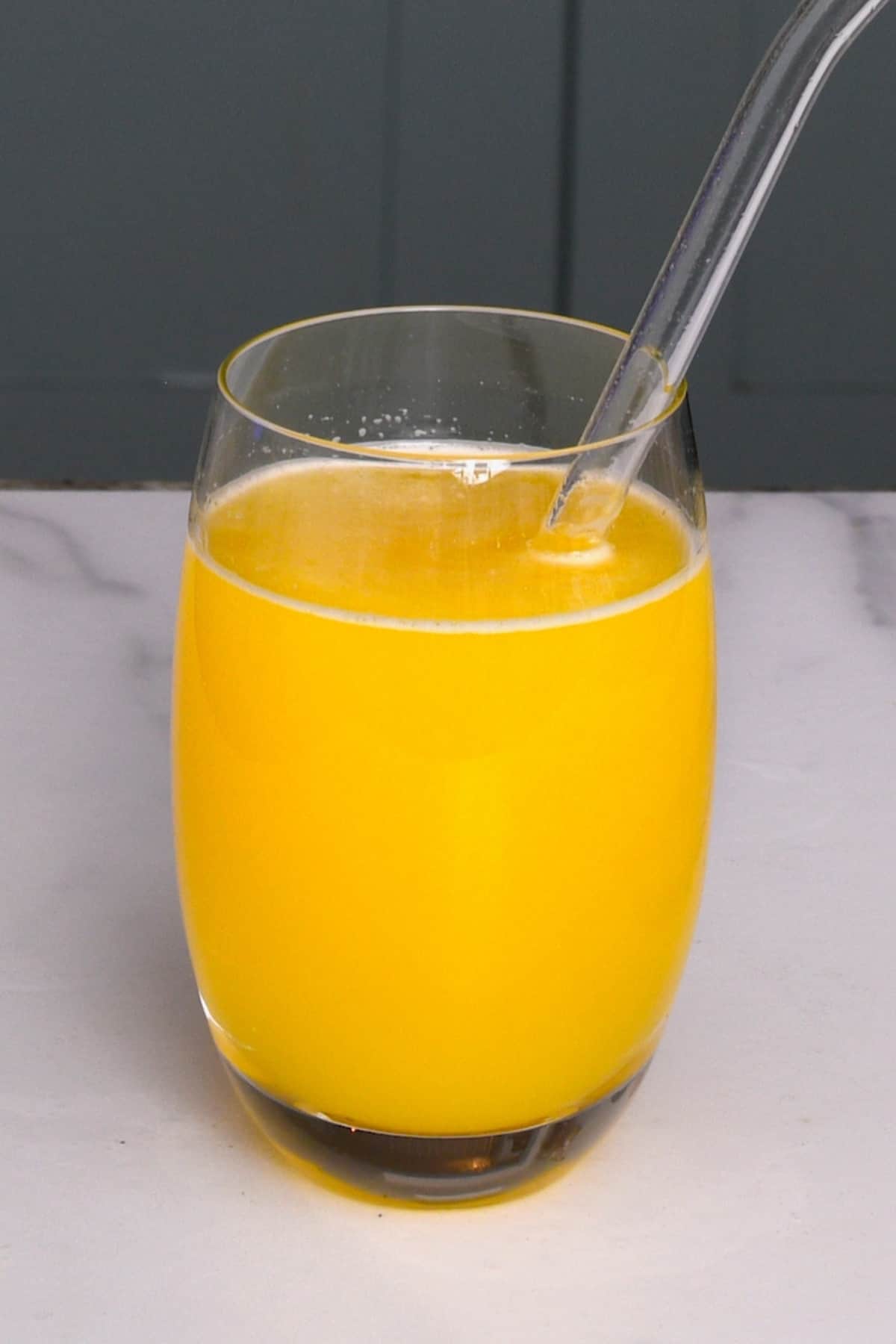
How to Make Pineapple Juice?
Using a Juicer
First, you need to chop the pineapple. Start by slicing off the bottom and top of the fruit. Then, with the pineapple stood upright. Use a long, sharp knife to slice off strips of the peel until it’s fully peeled. Then go back in with a smaller paring knife cut any remaining eye bits. For more tips, check out my post How To Cut A Pineapple!
Finally, chop it into rings, chunks, fingers, etc.- as long as the pieces are small enough to fit your juicer chute.
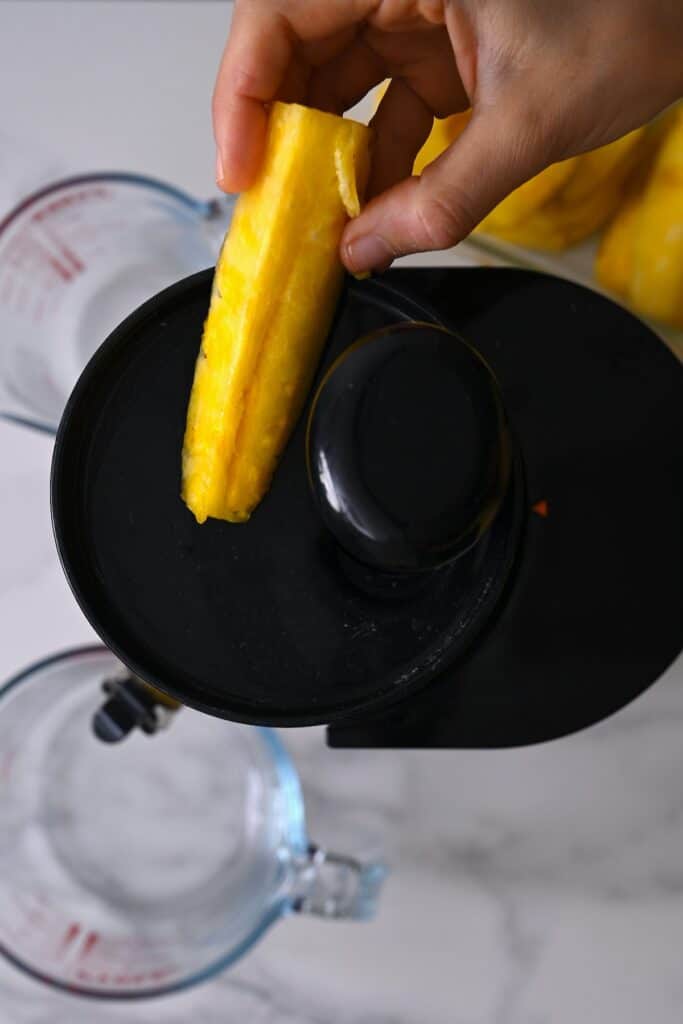
You can optionally core the pineapple, though that’s fine to juice too, and can even help push the softer pulp through your juicer.
Then, feed the pineapple through your juicer and let it do the work for you.
Using this method, one average pineapple will yield almost 3 cups (700 ml) of juice.
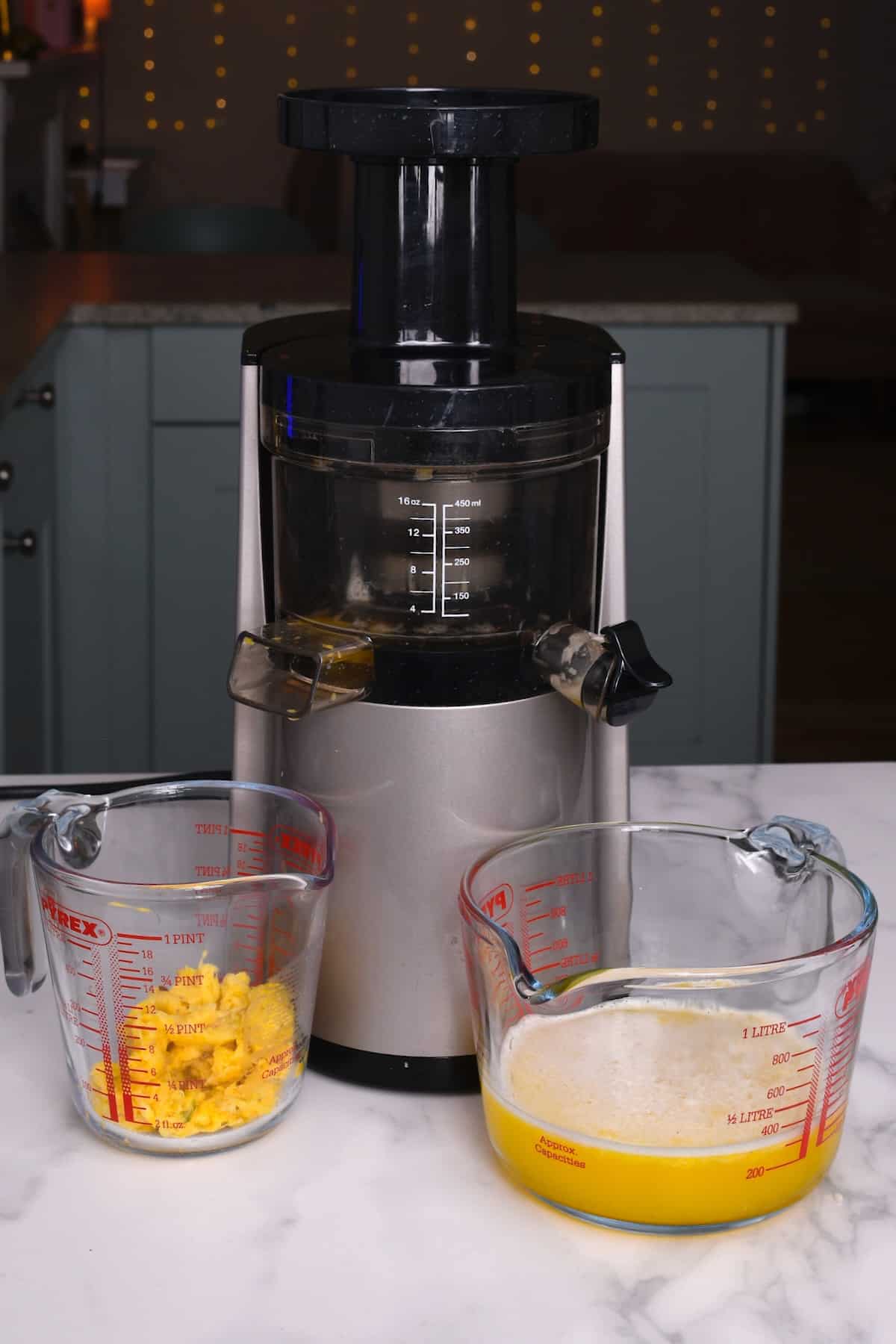
Juicer-free Method
First, peel and chop the pineapple into chunks, as written above.
Then, add the pineapple chunks to a high-speed blender jar and blend them into a smooth(ish) puree.
Although I didn’t add any extra liquid, you could add a small amount of water or coconut water if the pineapple puree needs help to become smooth and to your desired consistency. Alternatively, add the water/coconut water as ice cubes for a pineapple slushy consistency.
If you don’t mind pulpy juice, you can enjoy it as is. Otherwise, strain the mixture through a nut milk bag or fine mesh sieve/strainer. Make sure to squeeze out as much of the juice as you can.
Using this method, one average pineapple can yield about 3 ⅓ cups (800 ml) of juice.
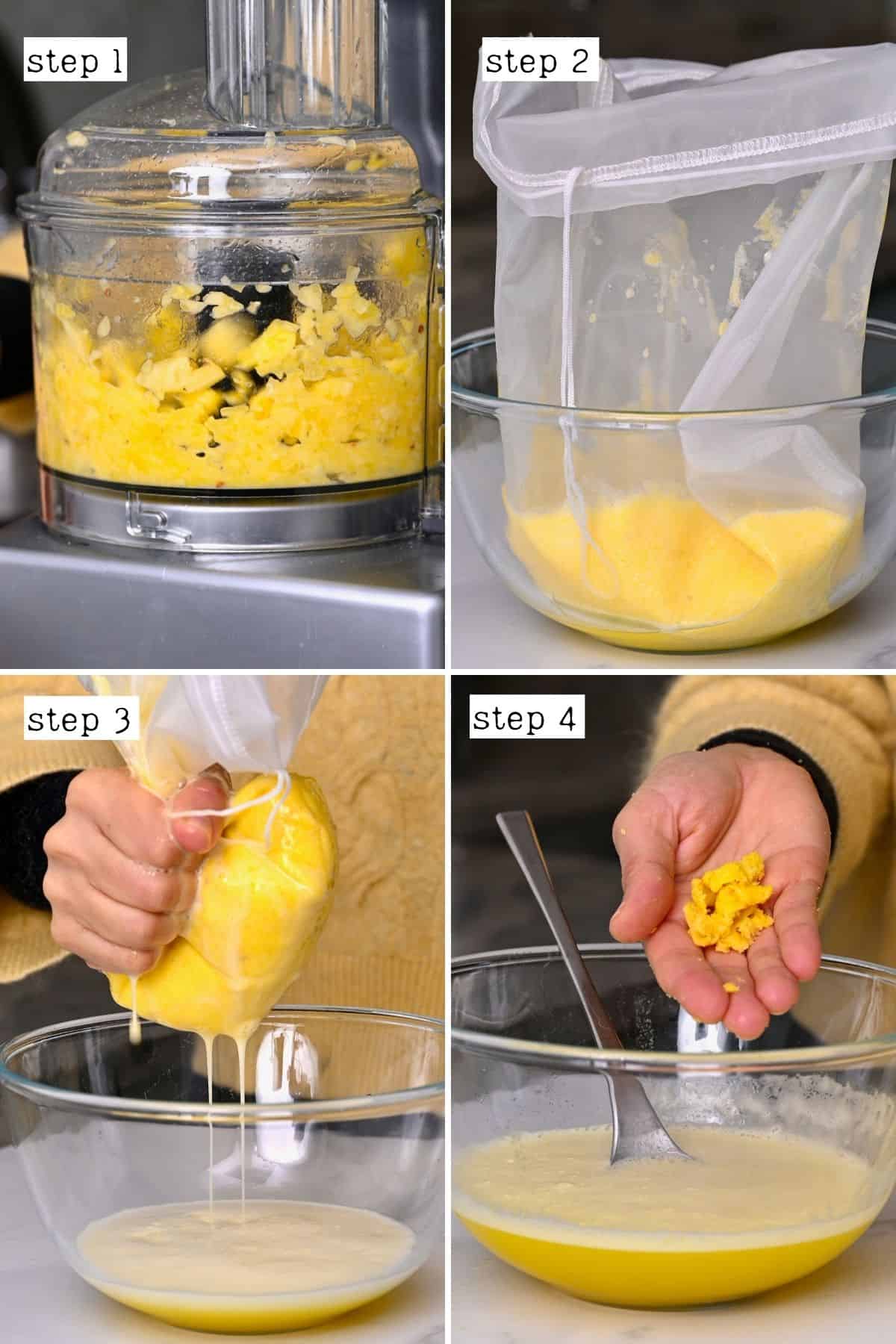
Pour the homemade pineapple juice into your glass of choice and enjoy it garnished with some mint or pineapple wedges!
Storing Instructions
Store: for optimal nutrient absorption and freshness, drink the homemade pineapple juice within 24 hours. However, you can store it in an airtight jug in the refrigerator for 3-4 days.
Freeze: I like to freeze the fresh pineapple juice in portions within a large or extra-large silicone ice cube tray for 4 months. That way, you can thaw just the right amount (stir it/shake before drinking) or even add it directly to a smoothie/slushy.
You can also freeze the leftover pineapple pulp similarly, either in an ice cube tray or a reusable Ziplock-style bag.
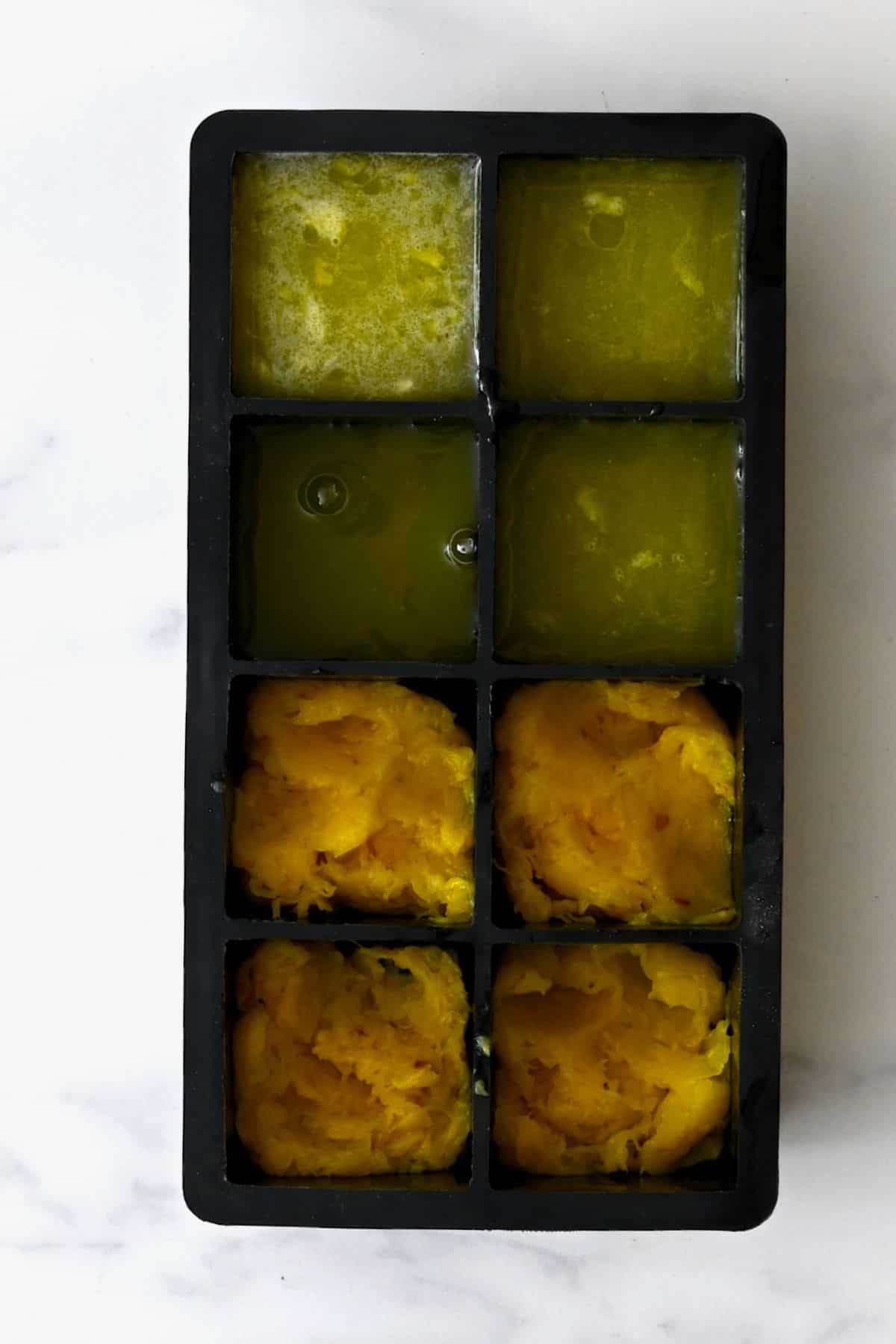
FAQs
Add it to smoothies, crackers, cakes/quick breads, or even to top granola bowls/parfaits, etc.
Likewise, there’s no need to waste the pineapple peel, which can make pineapple skin tea.
Absolutely! While it may not have a pleasant texture (usually tough/dry compared to the outer flesh), it’s still entirely edible and can 100% be juiced or blended (though it may struggle more in the latter).
In fact, the core contains several minerals (and fiber, which you can take advantage of when using the leftover juice pulp).
Just note that the pineapple core can be more irritative to the tongue/mouth, so enjoy it in moderation.
I like to have a glass of fresh juice first thing in the morning before eating breakfast for optimal absorption (or at least 30 minutes since eating).
According to Healthline, a 250ml cup contains 25g of fruit sugars.
Absolutely. I recommend transferring it to the freezer as soon as you’ve juiced it to retain as many nutrients as possible. The frozen pineapple juice should last up to 4 months.
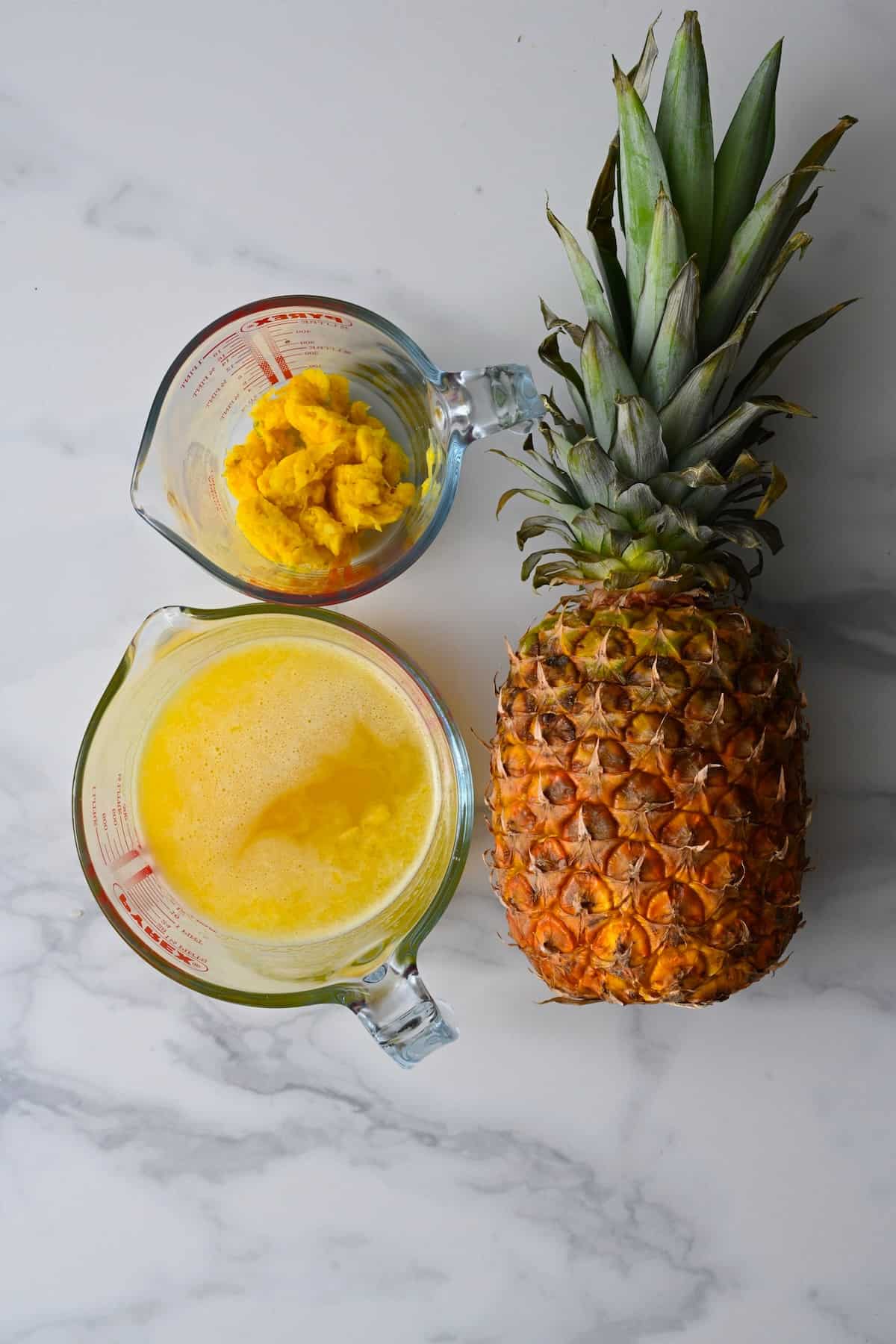
Recipe Tips and Notes
- For “instant” chilled pineapple juice: place the fruit in the refrigerator (whole or chopped) before juicing it.
- Using the core: if the core is particularly hard, you can omit it from either method, though you can use it for either, generally (though a blender may struggle with it if it’s not a high-speed one).
- To avoid jamming your juicer: it’s actually best to include the core, which will help to push the softer pulp through the juicer.
- The yield: this will vary depending on the exact size of the fruit. A “standard” pineapple will usually yield about 3 cups of juice (without pulp).
- Reduce waste: there are uses for the leftover pulp (in FAQs above), skin, and you could even plant the pineapple top to grow a pineapple plant.
More Fruit Juice Recipes
- Lemon Juice (6 methods)
- Apple Juice
- Grape Juice
- Cranberry juice
- Carrot juice
- Orange juice
- Watermelon juice (4 methods)
- Tomato juice (3 methods)
- Mango Juice
- Lime Juice (6 Methods)
- Peach Juice (Peach Nectar | 2 Methods)
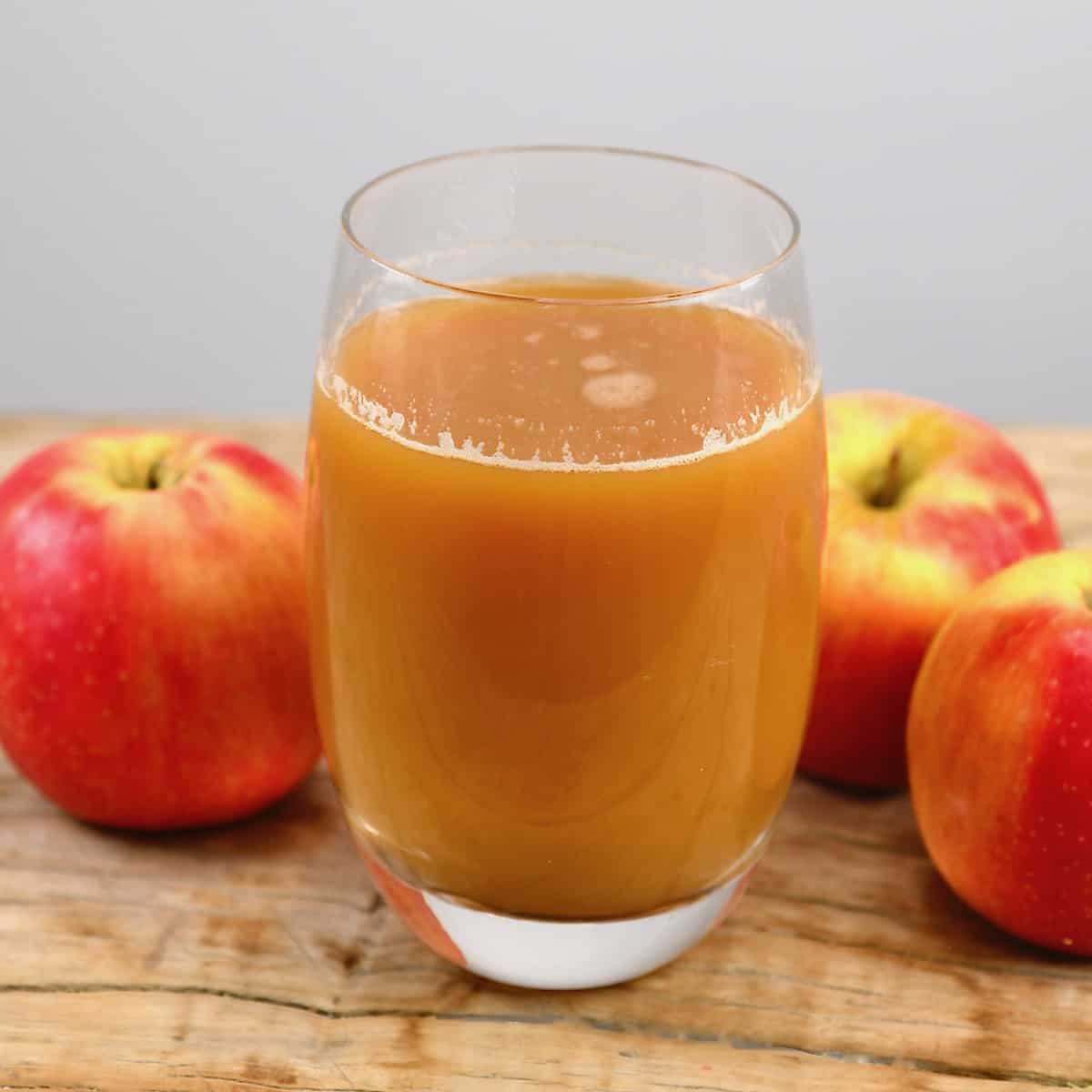
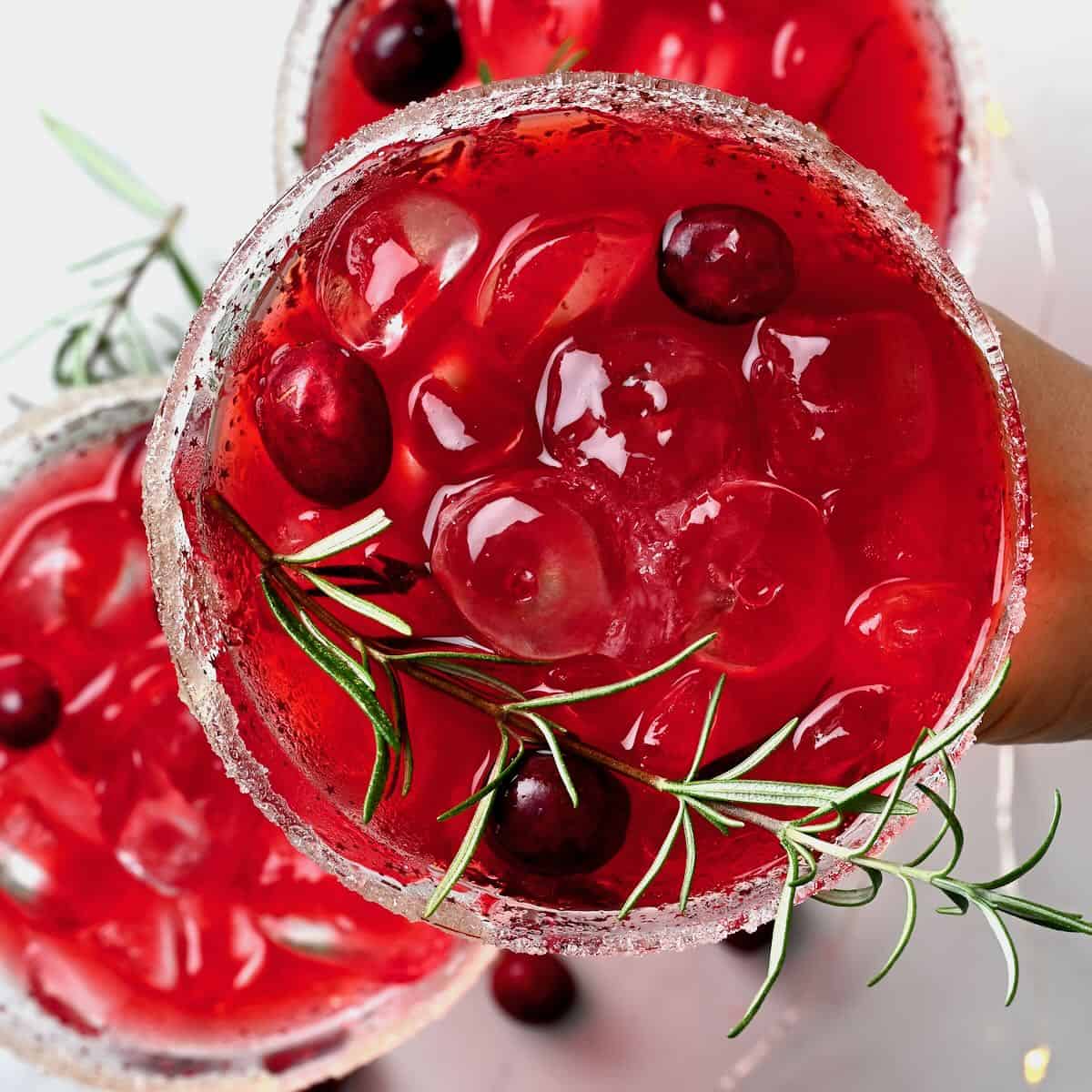
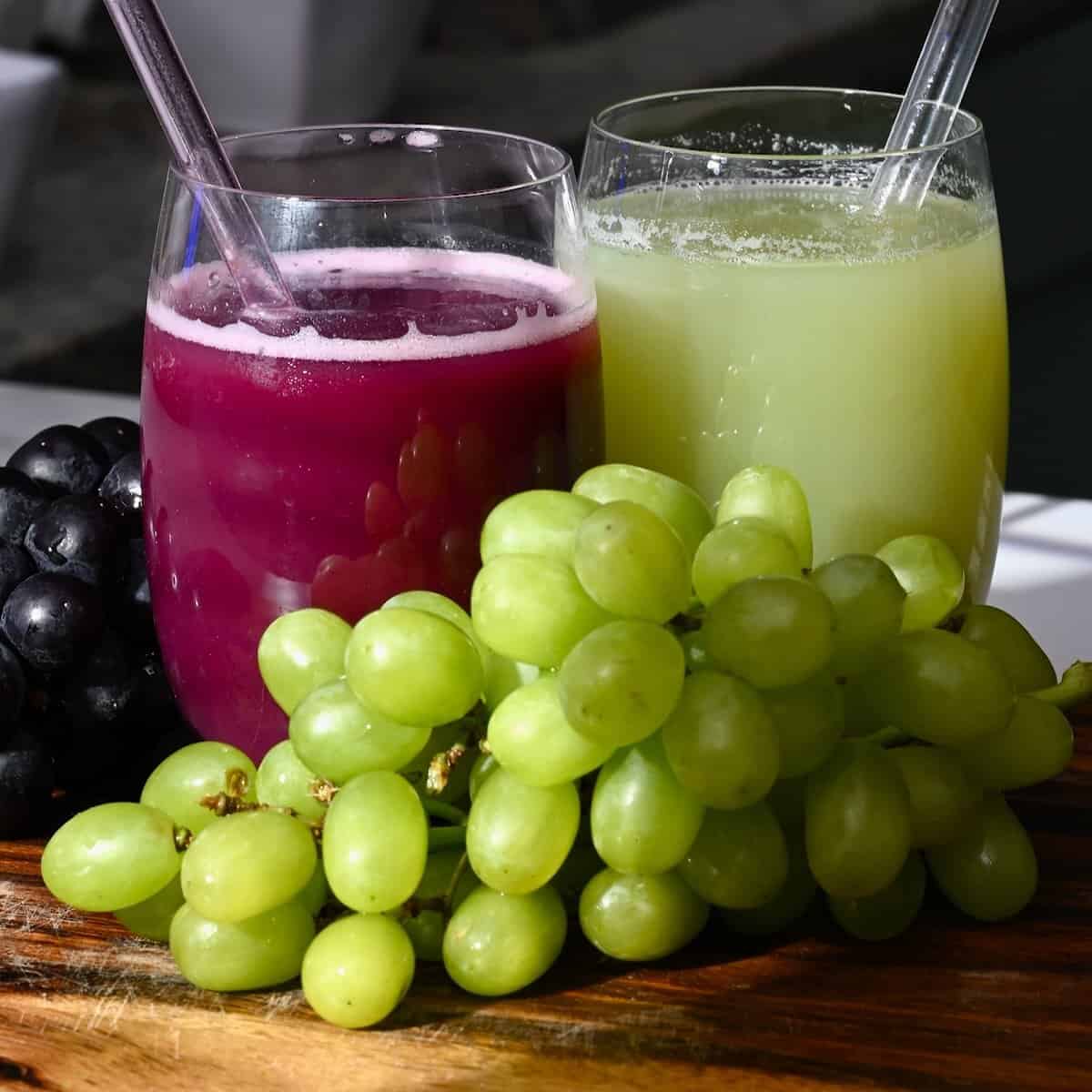
If you try one of these methods on how to make pineapple juice, I’d love to hear your thoughts/questions below. Also, I’d appreciate a recipe card rating below, and feel free to tag me in your recipe recreations on Instagram @Alphafoodie!
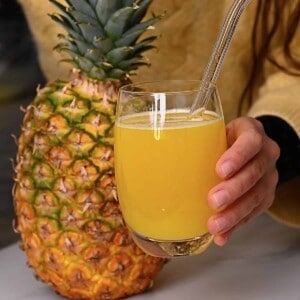
How To Make Pineapple Juice (With or Without Juicer)
Equipment
Ingredients
- 1 pineapple about 2 lb/1 kg; check the blog post for how to choose ripe pineapples
Instructions
- Slice off the bottom and top of the pineapple. With the pineapple stood upright, use a long, sharp knife to slice off strips of the peel until it's fully peeled. Then go back in with a smaller paring knife and cut any remaining eye bits.
- Chop it into rings, chunks, fingers, etc.- as long as the pieces are small enough to fit your juicer chute/blender jug.You can optionally core the pineapple, though that's fine to juice too, and can even help push the softer pulp through your juicer.
Using a Juicer
- Feed the chopped pineapple through your juicer and let it do the work for you.Using this method, one average pineapple will yield almost 3 cups (700 ml) of juice.
Juicer-free Method
- Add the pineapple chunks to a high-speed blender jar and blend them into a smooth(ish) puree.Although I didn't add any extra liquid, you could add a small amount of water or coconut water if the pineapple puree needs help to become smooth and to your desired consistency. Alternatively, add the water/coconut water as ice cubes for a pineapple slushy consistency.
- If you don’t mind pulpy pineapple juice, you can enjoy it as is. Otherwise, strain the mixture through a nut milk bag or fine mesh sieve/ strainer. Make sure to squeeze out as much of the juice as you can. Using this method, one average pineapple can yield about 3 ⅓ cups (800 ml) of juice.
Serve and enjoy!
- Pour the homemade pineapple juice into your glass of choice and enjoy it garnished with some mint or pineapple wedges!
Storing Instructions
- Store: for optimal nutrient absorption and freshness, drink the homemade pineapple juice within 24 hours. However, you can store it in an airtight jug in the refrigerator for 3-4 days. Freeze: I like to freeze the fresh pineapple juice in portions within a large or extra-large silicone ice cube tray for 4 months. That way, you can thaw just the right amount of frozen pineapple juice (give it a stir/shake before drinking) or even add it directly to a smoothie/slushy. You can also freeze the leftover pineapple pulp similarly, either in an ice cube tray or a reusable Ziplock-style bag.
Video
Notes
- For “instant” chilled pineapple juice: place the pineapple in the refrigerator (whole or chopped) before juicing it.
- Using the core: if the core is particularly hard, you can omit it from either method, though you can use it for either, generally (though a blender may struggle with it if it’s not a high-speed one).
- To avoid jamming your juicer: it’s actually best to include the core, which will help to push the softer pulp through the juicer.
- Pineapple to juice yield: this will vary depending on the exact size of the pineapple. A “standard” pineapple will usually yield about 3 cups of juice (without the pulp).
- Reduce waste: there are uses for the leftover pulp, skin, and you could even plant the pineapple top to grow a pineapple plant.
- Sweetener: if your pineapple isn’t particularly sweet, you could add a small amount of your favorite sweetener (granulated or liquid, like coconut sugar, honey, agave, etc.). Use a sugar-free sweetener like erythritol/swerve if preferred.
- Lemon/Lime: a small squeeze of fresh lime or lemon juice is a wonderful way to brighten the flavor further.
- Cumin powder: for an Indian twist add a pinch of cumin.
- Mint: serve the juice with a few mint leaves.
- Black salt: this doesn’t smell great but really works with pineapple juice and pairs well with cumin too.
- Salt & Black pepper: it may sound a little odd, but it really works to add that “something extra” to the fresh pineapple juice.
- Coconut water: coconut pineapple juice is super tropical. The coconut water dilutes the juice mixture while adding flavor.
Nutrition
Nutrition information is automatically calculated, so should only be used as an approximation.


